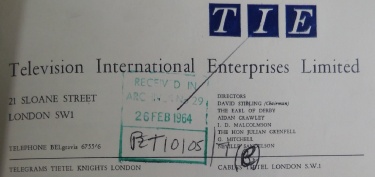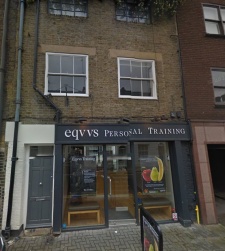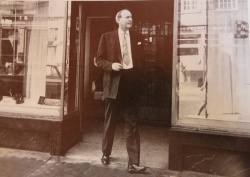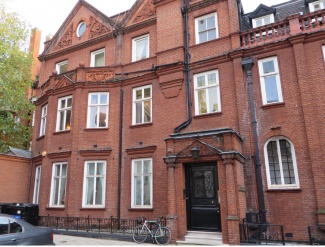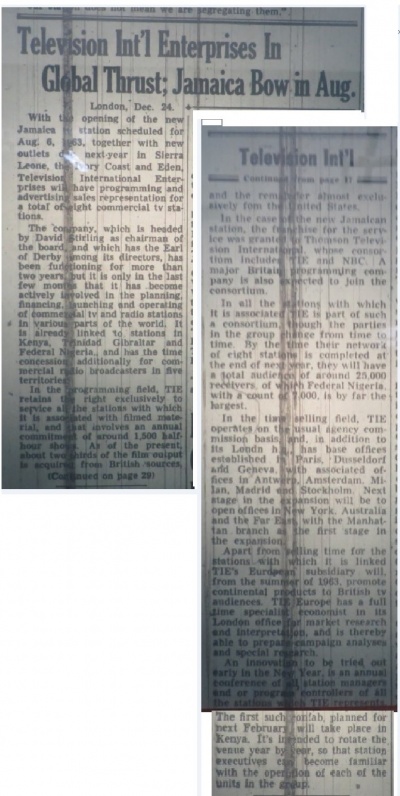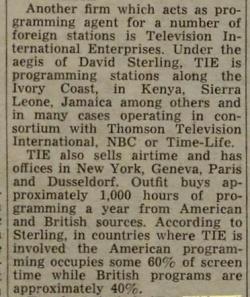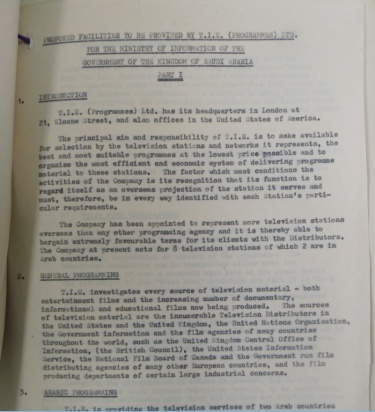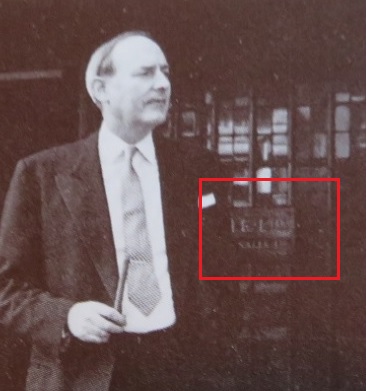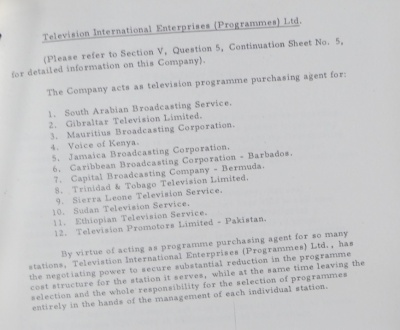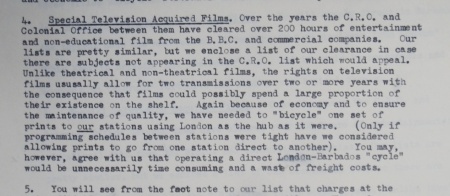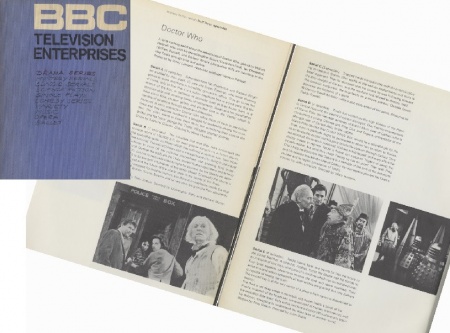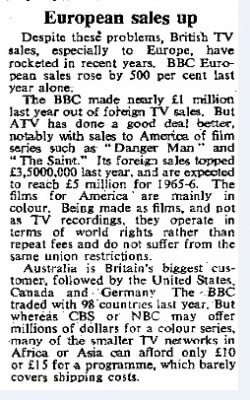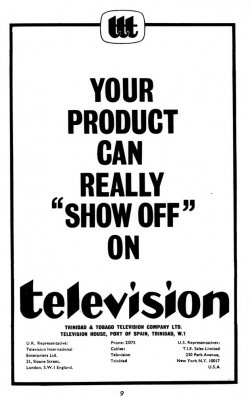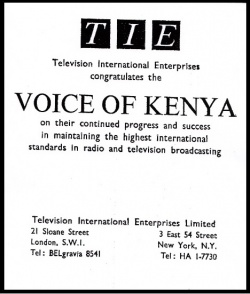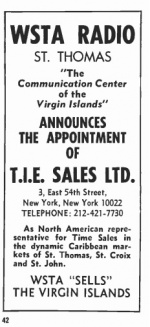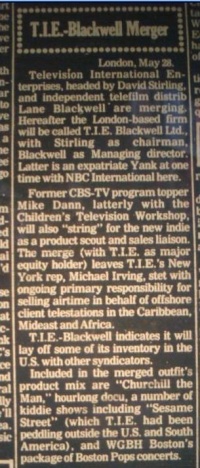Difference between revisions of "TIE Ltd"
Jon Preddle (talk | contribs) |
Jon Preddle (talk | contribs) |
||
| Line 98: | Line 98: | ||
[[File:TIESaudiDoc.jpg|thumb|right|375px|TIE's proposal issued to the Saudi government in late 1964]] | [[File:TIESaudiDoc.jpg|thumb|right|375px|TIE's proposal issued to the Saudi government in late 1964]] | ||
| − | <u>'''PART I'''</u> | + | <tt><u>'''PART I'''</u> |
*1. <u>'''INTRODUCTION'''</u> | *1. <u>'''INTRODUCTION'''</u> | ||
**TIE (Programmes) Ltd has its headquarters in London at 21, Sloane Street, and also offices in the United States of America. | **TIE (Programmes) Ltd has its headquarters in London at 21, Sloane Street, and also offices in the United States of America. | ||
| Line 136: | Line 136: | ||
*<u>'''CONCLUSION'''</u> | *<u>'''CONCLUSION'''</u> | ||
| − | **TIE (Programmes) Ltd, by virtue of its central offices, is able to act as an immediate clearing house for all the demands and problems of the television stations it represents on the one hand, and the offers and queries of the programme distributors on the other, <u>but at the same time ensuring that each station remains entirely responsible for, and in control of, its programme policies.</u> | + | **TIE (Programmes) Ltd, by virtue of its central offices, is able to act as an immediate clearing house for all the demands and problems of the television stations it represents on the one hand, and the offers and queries of the programme distributors on the other, <u>but at the same time ensuring that each station remains entirely responsible for, and in control of, its programme policies.</u></tt> |
| Line 194: | Line 194: | ||
The only known mention of '''TIE''' in any surviving BBC documentation is in a BBC Enterprises memo dated '''7 July 1965''' (discovered in late 2008), which states: | The only known mention of '''TIE''' in any surviving BBC documentation is in a BBC Enterprises memo dated '''7 July 1965''' (discovered in late 2008), which states: | ||
| − | : | + | :<tt>T.I.E. have bought prints for showing in [[Gibraltar]], [[Aden]], [[Trinidad & Tobago|Trinidad]], and [[Bermuda]] of Parts {{A}}–{{E}} @ £75 per print.</tt> |
| − | Next to this is a figure of £1,587 2 11. | + | Next to this is a figure of <tt>£1,587 2 11.</tt> |
With the sole exception of [[Australia]], which was sold all serials up and including [[The Crusade]], and [[New Zealand]] which had purchased only the first 13 episodes, the other eight countries named in the memo were also sold just the first five serials / 26 episodes, Parts {{A}} to {{E}}, up to and including [[The Keys of Marinus]]. | With the sole exception of [[Australia]], which was sold all serials up and including [[The Crusade]], and [[New Zealand]] which had purchased only the first 13 episodes, the other eight countries named in the memo were also sold just the first five serials / 26 episodes, Parts {{A}} to {{E}}, up to and including [[The Keys of Marinus]]. | ||
Revision as of 18:22, 26 February 2016
TELEVISION INTERNATIONAL ENTERPRISES LIMITED
London-based Television International Enterprises Limited (T.I.E. Ltd) (incorporated in June 1959) was a key player in the television industry in the early to late 1960s.
The company was created by David Stirling (founder of the Special Air Services (SAS)) to aid third world countries in Africa and the Middle East, and Commonwealth countries in the Caribbean to establish radio or television services (with the focus on education over entertainment) by assisting with funding, providing equipment and technical assistance, usually partnering by way of international consortia (sometimes referred to as "technical partners") with other major industry specialists, such as Thomson Television International in tandem with major US players such as Time-Life and networks like the National Broadcasting Company (NBC).
Once a station was up and running, TIE continued to be involved by acting as a representative agency through which radio and television programmes were supplied and advertising slots were sold.
Stirling had many other business interests from which he operated from the same offices, most notably private military and security company "Watchguard International Ltd". (WIL was created in 1967; Stirling ceased all Watchguard activity in 1972.) He also established Rally Films Ltd, which was used as a cover for more, er, less than official activities…
The company was initially based at 2 Dr Johnsons Buildings, in Temple, London, then from 1960 or 1961 at 43a Cheval Place, London. By 1963 it was in upstairs offices at 21-22 Sloane Street, London, before relocating to the second floor of 22 South Audley Street in Mayfair by 1971. (Stirling always maintained that it was a coincidence that he took an address with the initials "SAS"!)
TV T.I.E.-INS
The first television station that TIE helped create was that of Kenya, although the second station, in Nigeria, actually went to air first! It was reported in the 26 December 1962 edition of Variety magazine (see right) that by the end of 1963, only four years after it had been established, TIE Ltd would have representation for a total of eight commercial TV stations.
By the end of the decade, the TIE Consortium partnership had a hand in or was ultimately responsible for the raising of thirteen independent TV stations and supplying them with a number of programmes:
- Nigeria (NTS/NBC) (launched in April 1962)
- Kenya (1 October 1962)
- Trinidad (1 November 1962)
- Sudan (23 November 1962)
- Sierra Leone (27 April 1963)
- Jamaica (3 August 1963)
- Aden (October 1964)
- Ethiopia (November 1964)
- Barbados (15 December 1964)
- Mauritius (8 February 1965)
- Bermuda (ZFB) (August 1965)
- Hong Kong (TVB) (1967)
- Pakistan (1968)
To begin with, TIE had "the right exclusively to service all the stations with which it was associated with filmed material, and that involves an annual total of around 1,500 half-hour shows", of which two thirds were sourced from Britain (as noted in the 26 December 1962 edition of Variety).
But for how long that exclusivity lasted is not known. TIE was contracted by each station for however many years, and once that period was up, the contract was lapsed. Certainly, after several years of operation, when the TV stations no longer needed Thomson's involvement, and their ability to buy programming could be handled internally, the need for a sales and purchasing middleman decreased. Indeed, even the "represents exclusively'" declaration for those stations named in the WRTH print ads -- see below -- stops appearing after 1968.
And although "Television" was in the name, TIE also had a number of radio stations as customers. (TIE Sales was the US, Caribbean and African distributor for Stanmark Productions Ltd, who attempted to launch a series of Doctor Who radio serials in the 1960s.)
T.I.E. SALES
While the parent company, TIE Ltd, was bidding on tenders and setting up new TV stations, its subsidiary companies were busy with the day to day running of the stations, by providing sales and purchasing services.
TELEVISION INTERNATIONAL ENTERPRISES (SALES) LIMITED / TIE (SALES) LTD
This company was incorporated in January 1962, and was the main contact point for foreign television and radio producers looking for new markets to sell their product to. Rather than approaching radio and TV stations directly, they would instead deal with TIE.
US and UK-based sellers looking at advertising their wares on overseas radio and television stations would approach the relevant TIE sales office, which would buy commercial airtime on the stations it acted for. And for those foreign stations that also produced their own radio and television programming, TIE also acted as the agent selling those productions to other overseas markets.
TIE had a number of different offices around the world to handle these enquiries:
TIE (Sales)'s main base of operations was in New York, and was a joint-venture between TIE and US distributor Overseas Broadcast Services Ltd.
TIE (Sales) was the representative for the TV stations in the 13 countries listed above, plus numerous other radio stations within the USA, the Caribbean and Africa, such as Uganda, Malawi and Tanganyika (see the WRTH advertisements below).
The London-based parent company, TIE Ltd remained the US and foreign contact rep for stations in England and Europe only.
(The names "Television International Enterprises Ltd" or "TIE (Sales) Ltd" tend to be interchangeable when used in sales advertising, such as in the samples shown further down the page, although both are two separate companies albeit with similar function and purpose.)
During the early 1960s, another subsidiary, TIE (Europe) Ltd, had base offices in Paris, Dusseldorf, and Geneva, with associated offices in Antwerp, Amsterdam, Milan, Madrid and Stockholm. But by 1967, the European operation was moved to and handled out of London.
(Of note, by July 1965 (see below), the BBC had offered but failed to sell Doctor Who to the following countries: Italy, Sweden, United States, Netherlands, Switzerland, Lebanon, and Germany, all of which were -- coincidentally? -- countries where TIE had an associated office!)
For a very brief time in 1969 / 1970 (as noted in their print ad in the 1970 edition of WRTH), TIE used outside companies as points of representation in Toronto, Canada and Sydney, Australia.
From 1970, TIE (Sales) also had an office in Beirut, Lebanon (which was vacated during the 1975 Lebanese civil war).
By 1971, at the time of the Sesame Street contract (see below) the London office had taken over the UK representation for some of the Caribbean and African stations, as well as new markets in Asia, while the US sales fell under the control of a new subsidiary called TIE States Ltd.
TIE (Sales) was a regular attendee at television and radio promotion events such as the annual Cannes Television Film Festival, MIP-TV, MIPCOM, and NATPE where sales and distribution deals were made.
T.I.E. PURCHASING
One of TIE's other chief functions was to act as a purchasing agent for television stations; and as noted above, they had the exclusive rights to sell programmes to the TV stations they had helped create.
TELEVISION INTERNATIONAL ENTERPRISES (PROGRAMMES) LIMITED
This was the subsidiary that specifically handled programme purchases and distribution, sometimes undertaking the audition process. As reported in Variety magazine of 26 February 1964 (see above right), TIE purchased thousands of hours of programming a year from American and British sources, of which some 60% was from the US, and the other 40% from Britain. (With programmes provided by ITV companies, the BBC and other programme makers.)
The following select general terms and conditions are taken from a document written in late 1964 as part of TIE's bidding offer for the "PROPOSED FACILITIES TO BE PROVIDED BY TIE (PROGRAMMES) LTD" for a TV service in Saudi Arabia, and as such the same terms and conditions would have been those offered to past and future stations that TIE made bids for:
PART I
- 1. INTRODUCTION
- TIE (Programmes) Ltd has its headquarters in London at 21, Sloane Street, and also offices in the United States of America.
- The principal aim and responsibility of TIE is to make available for selection by television stations and networks it represents, the best and most suitable programmes at the lowest price possible and to organise the most efficient and economic system of delivering programme material to these stations. The factor which most conditions the activities of the Company is its recognition that its function is to regard itself as an overseas projection of the station it serves and must, therefore, be in every way identified with each Station's particular requirements.
- The Company has been appointed to represent more television stations overseas than any other programme agency and it is thereby able to bargain extremely favourable terms for its client with the Distributors. The Company at present [i.e. by 1964] acts for 8 television stations of which 2 are in Arab countries. [i.e. Aden and Sudan]
- 2. GENERAL PROGRAMMING
- TIE investigates every source of television material – both entertainment films and the increasing number of documentary, informational and educational films now being produced. The sources of television material are the innumerable Television Distributors in the United Sates and the United Kingdom, the United Nations Organisation, the Government information and the film agencies of many countries throughout the world, such as the United Kingdom Central Office of Information (the British Council), the United States Information Service, the National Film Board of Canada and the Government run film distributing agencies of many other European countries, and the film producing departments of certain large industrial concerns.
- 6. AVERAGE COST OF PROGRAMMES BOUGHT THROUGH TIE (PROGRAMMES) LTD AGENCY
- The average price during the past year (excluding films made available without cost and excluding freight charges) paid by an Arabic station acquiring imported programme material exclusively through TIE (Programmes) Ltd's agency, was about $28 (USA) or £10 sterling per half hour of programming.
- As noted in the summary of TIE's functions attached to this memorandum, TIE passes on all programmes negotiated on behalf of the Station at cost price, and the Company remuneration is restricted entirely to its annual fee.
- Presuming that the proposed television service … is run on the same general lines as other television services, the division between local station originated programmes (live and film) to imported programmes will tend to be on a ratio of about 60% imported to 40% locally originated. In the early stages, the ration is almost certain to be even higher in favour of imported material. Therefore, effective and economic access to high grade imported material is a vital consideration in the station's financial budget.
- 7. TIE (Programme) Ltd's Fee
- The scale of the TIE (Programme) Ltd's fee depends on the scale of programming required by the station or network. If 3½ hours or more per day of programming are required, the fee would amount to a maximum of £4,500 a year with direct accountable costs recoverable restricted to a maximum of £500 a year.
PART II
- SUMMARY OF THE SERVICES PROVIDED BY TIE (PROGRAMMES) LTD
- In addition to the responsibilities of negotiating and ordering television programmes for the stations it represents as outlined in Part I of this memorandum, TIE (Programmes) Ltd undertakes the following tasks:-
- a) i) Freighting of Programmes
- TIE undertakes responsibility for the control of all despatching of programmes both by air and surface to and between the stations it represents. To this end, Despatch Notices prepared in London are sent out and these inform the television Programme Department's [sic] of the date of receipt, transmission, and the despatch of each package of the programmes that TIE is providing.
- ii) TIE engages the services of a shipping agent, Messrs B & B Couriers Ltd, who maintain offices at London Airport and have representatives in New York, Africa and the Far East. Working in conjunction with TIE these shipping agents undertake the despatch of all programmes from London and supervise every shipment of films to and between the stations concerned.
- b) Film Handling
- A film handling department is maintained for the purpose of previewing and checking film that is available in the United Kingdom.
- c) Research
- Constant communication is maintained with all programme distributors, foundations and information agencies, to enable a comprehensive catalogue to be held by TIE of all entertainment, informative and educational films.
- d) Insurance
- Arrangements are made by TIE for the complete bulk insurance of all programmes whilst in transit, and while in the possession of each station, but not during projection of the prints.
- CONCLUSION
- TIE (Programmes) Ltd, by virtue of its central offices, is able to act as an immediate clearing house for all the demands and problems of the television stations it represents on the one hand, and the offers and queries of the programme distributors on the other, but at the same time ensuring that each station remains entirely responsible for, and in control of, its programme policies.
Under all those general terms and conditions, TIE (Programmes) had by the end of 1967, been directly responsible for negotiating programme purchases and shipping of film prints for the relevant TV stations in the following countries:
- Gibraltar
- Aden
- Ethiopia
- Kenya
- Mauritius
- Sierra Leone
- Sudan
- Barbados
- Bermuda (until 1966)
- Jamaica
- Trinidad
- Hong Kong
- Pakistan
Of this list, the stations TIE helped set up in Sudan, Pakistan and Hong Kong did not air Doctor Who.
(Hong Kong's TVB was the rival to Radiodiffusion's RTV, the channel that would go on to broadcast Doctor Who. It's intriguing to think that had TVB been set up two years earlier, TIE might have secured Doctor Who for that channel…)
TIE put in tenders for stations in other countries over the next few years, but failed to secure the contracts.
It's very clear from this standard agreement, that TIE (Programmes) operated on the direct instructions given it by the stations it represented. The stations themselves had the sole responsibility for and retained control of its programme selections and programme policies. TIE did not choose their programmes for them.
TIE would only purchase programmes selected by the stations; this would be from sales catalogues provided by the programme distributors. It purchased the programmes at a negotiated price, a cost which it then passed on to the station. TIE made its money by charging the station an annual commission.
Once the selection had been made by the station, TIE (Programmes) would negotiate the price with the seller and organise the supply of the films using one particular London-based shipping agent, B & B Couriers Ltd to transport the films between stations by air or by sea (see Bicycling Chains), and usually always from within its own network of stations.
That there was one courier firm engaged to transport films around the stations and there is no mention of films being stored anywhere does answer the question as to whether or not TIE operated a "bicycling hub" anywhere other than in London.
The company also dealt with such matters as insurance and checking the quality of film prints. As noted in this memo dated March 1964 [at right] relating to films being distributed to and from Barbados, for this particular batch of films, TIE had only one set of prints which were to be bicycled to its stations "using London as the hub". It's certain that this was so the London office could conduct quality checks on each film before being sent to the next destination, but it's clear from the last paragraph in this section of correspondence that from time to time when scheduling dictated otherwise and also from an economical angle, it was preferable to send films from country to country instead of using London as the intermediary.
See the table below for more on TIE (Programmes) Ltd's operations.
In summary,
- TIE Ltd: was the contact point in London, for programme makers and advertisers wanting to sell to or advertise on UK or European TV and radio stations that TIE represented
- TIE (Sales) Ltd: was the contact point in New York, for programme makers and advertisers wanting to sell to or advertise on US, Caribbean, African, Middle Eastern TV and radio stations that TIE represented
- TIE (Programmes) Ltd: negotiated with TV distributors to buy programmes at a reduced price on behalf of the TV stations they represented
"DOCTOR WHO AND THE T.I.E. WARRIOR"
Doctor Who was just one of hundreds of programmes for which TIE is known to have acquired in the mid-1960s.
At some point during late 1964 and early 1965, TIE negotiated with the BBC to buy the first five serials / 26 episodes of Doctor Who for four countries which would have selected the programme from a sales catalogue sent to them by the BBC (or by TIE, who got it from the BBC!).
All the stations named at the top of the page (with the exception of Sudan, Pakistan and TVB Hong Kong), would eventually screen episodes of Doctor Who during the 1960s or early 1970s. Whether TIE was involved with all those sales is unknown. For now we can only concern ourselves with the known 1965 sales.
The only known mention of TIE in any surviving BBC documentation is in a BBC Enterprises memo dated 7 July 1965 (discovered in late 2008), which states:
- T.I.E. have bought prints for showing in Gibraltar, Aden, Trinidad, and Bermuda of Parts A–E @ £75 per print.
Next to this is a figure of £1,587 2 11.
With the sole exception of Australia, which was sold all serials up and including The Crusade, and New Zealand which had purchased only the first 13 episodes, the other eight countries named in the memo were also sold just the first five serials / 26 episodes, Parts A to E, up to and including The Keys of Marinus.
It would appear that the sole reason why those five and those five only were being sold at that time is likely down to what was being promoted within BBC Enterprises' TV catalogue published during 1964. The cover of this brochure promoted "Drama Series, Mystery Serials, Classic Serials, Science Fiction, Single Plays, Comedy Series, Variety, Music, Opera, Ballet", and featured within its "science fiction serials half hour episodes" section was a little something called Doctor Who, with "Serial A", "Serial B", "Serial C", "Serial D" and "Serial E" being featured with a synopses and photographs. (See image above)
How Many Prints?
What's not clear from the wording in this 1965 memo is whether there were four sets of the 26 episodes sold by TIE (i.e. 104 prints in total), or three sets to be shared between the four (i.e. 78 prints) or two sets (52 prints in total), or just one single set of the 26.
This is because the total price recorded for this "sale" to TIE was £1,587 2'11 (in pre-decimal currency) at "£75 per print" -- but whether you calculate using 26, 52, 78 or 104, it does not compute! (£75 x 26 = £1,950; £75 x 52 = £3,900; £75 x 78 = £5,850; £75 x 104 = £7,800.)
One alternative reading of the memo is that "per print" means per "print of the story" -- i.e. £75 is the cost per serial. With five stories and four countries, the calculation becomes: £75 x 5 x 4 = £1,500. Okay, that's still £87 2'11 shy of the total -- perhaps that's postage and handling?! (That also means that a 2-parter cost the same to buy as a 7-parter!)
(There may also be the small matter of currency conversion to factor in: four different countries, four different currencies, the amount collected wouldn't necessarily always equate exactly to £75 each time…)
There is a remote possibility that the £75 is a typo, and it should be £15 for each of the 104 prints, which allowing for the shillings and pence, £1,587 2'11 does work out roughly at £15 2'6 per print. (As a comparison, Singapore paid £14 6' per print, total £371 8'7. That times 4 = roughly £1,487, which is £100 less than the TIE price, a difference made up by adding £1 to the price of each print, which takes us back to £15 or so.)
As noted in the general terms and conditions outlined above, the standard cost in 1964 for a half hour programme for stations in the Middle East was £10. And in an article about the sale of BBC programmes in the 3 April 1966 edition of The Observer (see right), it is noted that "many of the smaller TV networks in Africa or Asia can afford only £10 or £15 for a programme, which barely covers shipping costs". (our emphasis) So the average price per half hour film for the countries that TIE would be acting for was no more than £15.
On a different tangent, if we ignore the fact that four countries are specifically named in the memo, and interpret the pricing structure to mean "T.I.E. have bought prints of Parts A–E @ £75 per print", then the £75 could be a single amount that TIE negotiated as a bulk deal for all countries under its responsibility, not just the four that are named. At the time the memo was drawn up, TIE (Programmes) was the purchasing agent for eight countries, and £75 was the blanket price paid by TIE which permitted it to sell to those eight. That makes the per episode cost per country just under £10, which fits within the standard pricing being offered elsewhere for those same 26 episodes. (£75 x 26 = £1,950 / 8 = £244 / 26 = £9.35)
But if all the elements of the memo are correct, in order to arrive precisely at £1,587 2'11 when using £75 as a whole value, there would have to be a fraction in the calculation; a percentage or even a percentage of a percentage? But what percentage and of what amount? (e.g. £75 x 26 = £1,950 x 81½% = £1,589)
By the time that memo was written, Aden had screened An Unearthly Child part one and Gibraltar had aired up to Inside the Spaceship on 29 June. The other two TIE countries didn't air the series until October and December respectively. So another possible answer is that the amount shown is merely a "sum paid so far"; this odd total could be an instalment received from the GBC and Aden (21 x £75 = £1,575, plus £12 2'11 shipping and handling?).
Of note, there is no overlap of the airdates in any of those four countries, which would be the case when there was only one print being moved around. Had TIE more than the one print, then there really ought to be at least one overlap of dates between the countries.
If there was just the one set, the film prints were likely sent to Gibraltar first as it was the nearest in terms of distance from London, then to Aden, then over to the two Caribbean countries (and perhaps with the films still going via London for checking before despatch to the next destination…)
That the countries are listed in the memo in the same order in which the series did end up going to air, is probably entirely coincidental since the person who compiled the memo would have had absolutely no knowledge of what TIE's internal processes and film-sharing procedures were, nor how and when they actually intended to circulate those films months down the track, or the order in which they would go to air. Plus, there was always the possibility that between the sale, when this memo was circulated and when the episodes finally went to air, those plans could easily change.
Indeed, the order in which the first ten countries are recorded in that memo mostly mirrors the same order in which they appear in the Clearances paperwork. Did the writer of the memo simply consult the Clearances registers?
The only solid reason why the BBC would need to know the precise order in which the countries were to air the series would be if the BBC themselves was supplying the prints to those countries directly, but which as noted earlier in the agreement terms and conditions, does not appear to be the case.
Conclusion
So, how many prints did TIE buy by July 1965?
After weighing up the options, our instinct is that TIE bought the rights to those 26 episodes by paying the BBC a bulk flat fee of £75 per episode and acquired one set of 26 prints for sharing around however many of the countries that it represented and charging them no less than £10 each episode in order to make back its money: 26 x £75 = £1,950. TIE represented eight countries at that time, so £1,950 / 8 potential sales = £244 per country, and that divided by 26 = £9.3 per episode.
And if each of the eight stations paid TIE between £10 and £15 per episode (including shipping costs?) per the pricing terms of its agreement with the provider, TIE would make a very small profit on the deal, on top of its annual commission.
As of mid-1965, it had successfully sold the series to four countries, and with each of the four paying somewhere between £10 and £15 (£15 x 4 x 26 = £1,560) the £1,587 2'11 is close enough to represent the total paid from those four sales (with perhaps the first instalment from a fifth country to make up the difference?).
And by the end of 1966, Doctor Who had been sold to eight countries that TIE represented; the company therefore did not make a loss on its initial £75 per episode investment.
With the exception of Bermuda, the three other countries named in that memo would go on to screen further episodes after the first 26, but all three stopped screening Doctor Who by the end of 1967. And of the ten stations that TIE represented, only one would still be showing Doctor Who in 1971.
Whether TIE was involved with other blocks of sales after 1965 is not documented. But the fact that those countries dropped the series a few years later means either TIE did a poor job when it came to negotiating to buy more Doctor Who, or the stations themselves just simply weren't interested in purchasing any more, or factors beyond their control interfered, such as civil wars, political unrest, and the closure of major shipping routes through canals…
The BBC may not have been able to liaise directly with the broadcasters for any subsequent purchases if TIE retained the exclusive rights to act for those countries, hence why so many stopped the series with The Rescue. But once the contract with TIE expired (see below) and that "exclusivity" was gone, the BBC would have been able to step in, as evidenced by the fact that Gibraltar was still buying new episodes of Doctor Who well into the 1980s, almost certainly without TIE's involvement.
To answer the question at the top of this section, we think TIE took possession of one set of 26 film prints, and bicycled them initially between the four countries named in the memo, then later on to three further countries: Jamaica, Barbados, and Ethiopia.
"ONE OF THESE THINGS IS NOT LIKE T.I.E. OTHER"
One of TIE's greatest achievement came in late 1970 / early 1971 when it was contracted by the Children's Television Workshop to sell Sesame Street to broadcasters throughout Africa, Europe and the Far East.
(It may be purely coincidental that the final round of sales of Doctor Who to broadcasters that were on TIE's books - such as Sierra Leone and Ethiopia - were in 1970. Did the acquisition of the CTW contract in early 1971 force the distributor to drop or at least minimise its association with the BBC in order to concentrate on promoting Kermit and co around the world, or – as noted above – had TIE's brief association with Doctor Who already ended in 1965?)
The fact that TIE successfully sold Sesame Street to a significant number of countries in Africa suggests that the distributor may have operated a central distribution point – or "bicycling hub" – in Africa for a time through which the films would be routed. But such a facility would have to store multiple prints of hundreds of episodes of Sesame Street as well as any other programming it was also selling.
However, since TIE Sales at that time only had offices in London, Beirut and New York (where the Children's Television Workshop was also based) from which the films would be struck, stored and despatched, and there were already very robust bicycling systems operating in West and East Africa for the movement of films, as far as Sesame Street was concerned, there was no need for a storage "hub" in Africa, the Middle East or Asia.
In other words, if such a facility existed, it would have been used for the distribution of Sesame Street, but extant documentation indicates that the bicycling system, in which the broadcasters act as "hubs", was used instead.
Distribution centres are discussed in more on the Bicycling Chains page.
TIE was still selling Sesame Street well into the mid-1980s.
PROMOTING T.I.E.
TIE placed small advertisements in several industry journals and publications such as Broadcasting, and full page print ads in eight editions of the World Radio Television Handbooks (WRTH) from 1965 to 1972. (Note, although dated with the year, each volume was actually published in the last quarter of the previous year.) Here is a small sample:
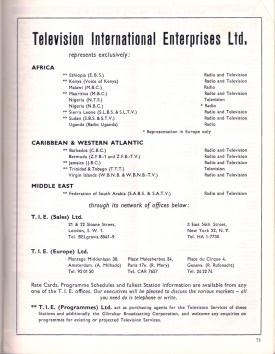 Print ad for TIE Ltd; from WRTH 1966 |
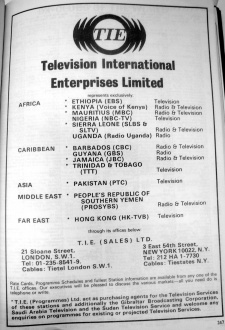 Print ad for TIE Ltd; from WRTH 1969 |
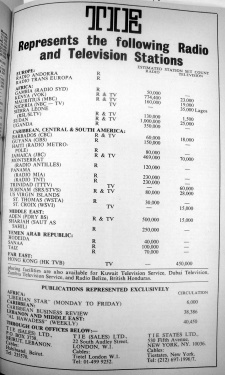 Print ad for TIE Ltd; from WRTH 1972 |
WRTH Print Ads
Tabulated below are the TV stations that are named in the eight WRTH print ads and which also have an asterisk denoting that they have "TIE (Programmes) Ltd acting as purchasing agent".
- The ones marked with "F" are those that feature only in the footnote at the bottom of the page, not the main list.
- Those marked "P", are listed in a separate section which identifies the stations having "placing facilities".
- The symbol -X-, -F- or -- indicates that Doctor Who aired on that TIE station during that same year.
| YEAR | 1965 | 1966 | 1967 | 1968 | 1969 | 1970 | 1971 | 1972 | Notes |
| Ethiopia | X | X | X | X | X | -F- | -F- | -- | TIE (Sales) no longer represents ETV from 1970, but TIE (Progs) act as purchaser |
| Kenya | X | -X- | -X- | X | X | X | X | ||
| Mauritius | X | -X- | -X- | -X- | X | X | X | ||
| Sierra Leone | X | X | -X- | -X- | X | -X- | -X- | SLTV became independent of the TIE Consortium in 1971 | |
| Sudan | X | X | X | X | F | X | X | What is the significance of Sudan being footnoted only in 1969? | |
| Barbados | X | -X- | -X- | -X- | X | X | Barbados is no longer footnoted after 1970 | ||
| Jamaica | X | -X- | -X- | X | -X- | X | X | ||
| Trinidad | -X- | -X- | X | X | X | X | X | ||
| Aden | -X- | -X- | X | X | X | X | X | ||
| Hong Kong | X | X | X | X | Hong Kong is no longer footnoted after 1970 | ||||
| Pakistan | F | X | X | X | Pakistan moves from being a footnote in 1967 to the full list, but is no longer footnoted after 1970 | ||||
| Gibraltar | -F- | -F- | F | F | F | F | F | -- | |
| Saudi Arabia | F | F | F | F | F | ||||
| Abu Dhabi | F | F | Abu Dhabi's TV station was launched in 1969 | ||||||
| Kuwait | P | P | |||||||
| Dubai | P | P | Dubai's TV station was launched in 1972 | ||||||
| Zambia | P |
NOTES
- There is no footnote in the 1972 ad. Why? Is this simply due to lack of space on the already very full page, or is it because TIE (Programmes) was no longer acting as purchasing agent for any of the stations? (Had there been any, chances are the footnotes would be very similar if not identical to the 1971 list.)
- TIE was a key member of the international consortia that built the TV stations in all the African and Caribbean countries listed above. TIE was officially no longer involved with Sierra Leone TV after 1971.
- Bermuda makes an appearance in the 1965 edition, but only for radio, then does not appear in any subsequent ad. ZFB-TV was established in August 1965 with the aid of the TIE Consortium. (Had there been a full page TIE ad in the 1964 WRTH, Bermuda TV would probably have been included.) But in early 1966, ZFB-TV became an affiliate of the US network ABC, who replaced TIE as its exclusive programme supplier. That sudden change of distributor would explain why Bermuda's TV station is absent from the 1965 edition and why Doctor Who did not air in Bermuda beyond the initial 26 purchased for them by TIE.
- Placing Facilities: We understand that this refers to the service by which a broadcaster rents out its studios and equipment to other broadcasting and production companies to use while the host broadcaster is off the air. TIE would have been the agent through which these rentals were arranged.
- If TIE had continued to place ads like these in the WRTHs, it would be interesting to see which stations were dropped from the line-up with each new edition.
Our attempts at tabulating some of the bicycling paths between countries within these regions can be seen on the Bicycling Chains page.
THE FINAL DAYS OF T.I.E.
The last print ad to appear in the WRTH was the one in the 1972 edition (published in late 1971). Three of the stations footnoted in 1970 as having TIE (Programmes) Ltd as purchasing agent are gone from the 1971 ad. Is that in any way significant?
Also of possible significance is that TIE (Sales) Ltd rarely features in any industry journal or similar publication after 1972, whereas prior to then it is quite prolific. (Any online search for the TIE names fails to bring up much dated after 1972.) TIE's contracts with the television stations it helped create were often for ten to 15 years; so by the mid-1970s, most of those contracts were beginning to expire, and presumably not renewed.
Of the TV stations that TIE helped set up, only Ethiopia was still screening Doctor Who in 1972. And the only station that is named in all of the WRTH ads still screening the show after 1973 was Gibraltar, a station which TIE did not help establish. From this, we could conclude that TIE's programme purchasing contracts with all the other stations that it did help establish had well and truly lapsed by the end of 1973.
In May 1974, (and presumably as a direct result of it no longer having annual commission income from the stations it once has exclusive rights with) TIE Ltd merged with another London-based international TV distributor, Lane Blackwell Limited; the joint-venture becoming TIE-Blackwell Ltd. (The joint-venture was still based at the South Audley Street address.) But in February 1975, less than one year later, this co-venture came to an end. Lane Blackwell went back to distributing programmes on a solo basis.
(Of note, there is no company called TIE-Blackwell Limited registered at the UK companies office, and yet the full name is used on advertising material that appeared in the 8 January 1975 edition of Variety.)
(Also of note is that the film delivery company B & B Couriers Ltd used by TIE appears to have stopped trading around 1973/74 -- was this another reason for the merger? Did TIE seek a replacement delivery mechanism through Lane Blackwell?)
TIE Ltd continued distributing for at least another decade but in a much-reduced capacity following a major internal restructure: for instance, TIE (Europe) Ltd was renamed TIE (Fiji) Ltd in December 1976. Its film production company, TIE (Productions) Ltd (registered in March 1963) was wound down by the end of the 1980s.
In the early to mid-1980s, the company sold mainly US sports programmes, such as American football, to terrestrial markets in the USA and Europe. Satellite and other forms of TV distribution were then still in their infancy, but as those methods began to proliferate worldwide in the mid- to late-1980s, and the need to bicycle film and video tape around the globe decreased, companies like TIE ultimately became redundant.
TIE eventually ceased trading following the death of its founding-director, Sir David Stirling in November 1990. But the company had already reduced its operations long before then.
A proposal to wind up the parent company was issued in early 1991, as was notified in the 13 May 1991 issue of The London Gazette, and the final meeting of the creditors to discuss the disposal of assets was subsequently held a few years later, on 29 April 1994, as was notified in The London Gazette of 31 March 1994. No longer trading, the parent company seemed to carry on in name only under caretaker management until the mid-2000s.
An application for TIE (Sales) Ltd to be struck from the companies' register was filed on 13 January 1999.
After some 40 years in business, Television International Enterprises Limited ended not with a bang but a whimper. Its small role back in 1965 as far as Doctor Who was concerned was completely unknown until the discovery of that July 1965 memo in late 2008. Whether TIE had any involvement with selling Doctor Who after 1965 is unknown. As noted earlier, the lack of paperwork held by the BBC identifying TIE after that year strongly suggests they didn't. It was a sale of five stories to four countries in 1965 only.
The Sloane Street building where the 1965 Doctor Who deals were done is long gone. The other three addresses from which TIE had operated still stand today; 22 South Audley Street is currently occupied by a private security firm, which brings the story almost full circle...
(With grateful thanks to Steve Traves)
